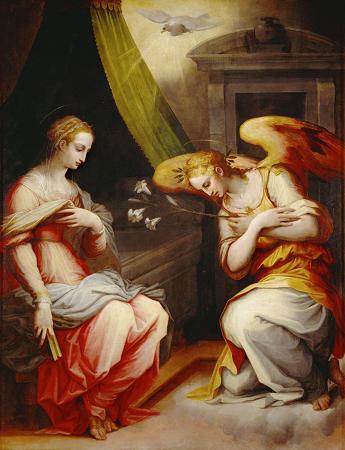Giorgio Vasari (1511 - 1574). Giorgio Vasari was an Italian painter, architect, writer, and historian, most famous today for his Lives of the Most Excellent Painters, Sculptors, and Architects, considered the ideological foundation of art-historical writing. He was also the first to use the term Renaissance in print. Vasari was born prematurely on 30 July 1511 in Arezzo, Tuscany. Recommended at an early age by his cousin Luca Signorelli, he became a pupil of Guglielmo da Marsiglia, a skillful painter of stained glass. Sent to Florence at the age of sixteen by Cardinal Silvio Passerini, he joined the circle of Andrea del Sarto and his pupils Rosso Fiorentino and Jacopo Pontormo, where his humanist education was encouraged. He was befriended by Michelangelo, whose painting style would influence his own. He died on 27 June 1574 in Florence, Grand Duchy of Tuscany, aged 62. In 1529, he visited Rome where he studied the works of Raphael and other artists of the Roman High Renaissance. Vasari's own Mannerist paintings were more admired in his lifetime than afterwards. In 1547 he completed the hall of the chancery in Palazzo della Cancelleria in Rome with frescoes that received the name Sala dei Cento Giorni. He was consistently employed by members of the Medici family in Florence and Rome, and worked in Naples, Arezzo and other places. Many of his pictures still exist, the most important being the wall and ceiling paintings in the Sala di Cosimo I in the Palazzo Vecchio in Florence, where he and his assistants were at work from 1555, and the frescoes begun by him inside the vast cupola of the Duomo were completed by Federico Zuccari and with the help of Giovanni Balducci. He also helped to organize the decoration of the Studiolo, now reassembled in the Palazzo Vecchio. In Rome he painted frescos in the Sala Regia. Among his other pupils or followers are included Sebastiano Flori, Bartolomeo Carducci, Domenico Benci, Tommaso del Verrocchio, Federigo di Lamberto, Niccolo Betti, Vittor Casini, Mirabello Cavalori, Jacopo Coppi, Piero di Ridolfo, Stefano Veltroni of Monte San Savino, Orazio Porta of Monte San Savino, Alessandro Fortori of Arezzo, Bastiano Flori of Arezzo, Fra Salvatore Foschi of Arezzo, and Andrea Aretino. Aside from his career as a painter, Vasari was also successful as an architect. His loggia of the Palazzo degli Uffizi by the Arno opens up the vista at the far end of its long narrow courtyard. It is a unique piece of urban planning that functions as a public piazza, and which, if considered as a short street, is unique as a Renaissance street with a unified architectural treatment. The view of the Loggia from the Arno reveals that, with the Vasari Corridor, it is one of very few structures that line the river which are open to the river itself and appear to embrace the riverside environment. In Florence, Vasari also built the long passage, now called Vasari Corridor, which connects the Uffizi with the Palazzo Pitti on the other side of the river. The enclosed corridor passes alongside the River Arno on an arcade, crosses the Ponte Vecchio and winds around the exterior of several buildings. It was once the home of the Mercado de Vecchio. He also renovated the medieval churches of Santa Maria Novella and Santa Croce. At both he removed the original rood screen and loft, and remodelled the retro-choirs in the Mannerist taste of his time. In Santa Croce, he was responsible for the painting of The Adoration of the Magi which was commissioned by Pope Pius V in 1566 and completed in February 1567. It was recently restored, before being put on exhibition in 2011 in Rome and in Naples. Eventually it is planned to return it to the church of Santa Croce in Bosco Marengo. In 1562 Vasari built the octagonal dome on the Basilica of Our Lady of Humility in Pistoia, an important example of high Renaissance architecture. In Rome, Vasari worked with Giacomo Barozzi da Vignola and Bartolomeo Ammannati at Pope Julius III's Villa Giulia. Main article: Lives of the Most Excellent Painters, Sculptors, and Architects Often called the first art historian, Vasari invented the genre of the encyclopedia of artistic biographies with his Le Vite de' piu eccellenti pittori, scultori, ed architettori, dedicated to Grand Duke Cosimo I de' Medici, which was first published in 1550. He was the first to use the term Renaissance in print, though an awareness of the ongoing rebirth in the arts had been in the air since the time of Alberti, and he was responsible for our use of the term Gothic Art, though he only used the word Goth which he associated with the barbaric German style. The Lives also included a novel treatise on the technical methods employed in the arts.
more...














